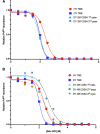Evidence for preexisting prion substrain diversity in a biologically cloned prion strain
- PMID: 37669293
- PMCID: PMC10503715
- DOI: 10.1371/journal.ppat.1011632
Evidence for preexisting prion substrain diversity in a biologically cloned prion strain
Abstract
Prion diseases are a group of inevitably fatal neurodegenerative disorders affecting numerous mammalian species, including Sapiens. Prions are composed of PrPSc, the disease specific conformation of the host encoded prion protein. Prion strains are operationally defined as a heritable phenotype of disease under controlled transmission conditions. Treatment of rodents with anti-prion drugs results in the emergence of drug-resistant prion strains and suggest that prion strains are comprised of a dominant strain and substrains. While much experimental evidence is consistent with this hypothesis, direct observation of substrains has not been observed. Here we show that replication of the dominant strain is required for suppression of a substrain. Based on this observation we reasoned that selective reduction of the dominant strain may allow for emergence of substrains. Using a combination of biochemical methods to selectively reduce drowsy (DY) PrPSc from biologically-cloned DY transmissible mink encephalopathy (TME)-infected brain resulted in the emergence of strains with different properties than DY TME. The selection methods did not occur during prion formation, suggesting the substrains identified preexisted in the DY TME-infected brain. We show that DY TME is biologically stable, even under conditions of serial passage at high titer that can lead to strain breakdown. Substrains therefore can exist under conditions where the dominant strain does not allow for substrain emergence suggesting that substrains are a common feature of prions. This observation has mechanistic implications for prion strain evolution, drug resistance and interspecies transmission.
Copyright: © 2023 Gunnels et al. This is an open access article distributed under the terms of the Creative Commons Attribution License, which permits unrestricted use, distribution, and reproduction in any medium, provided the original author and source are credited.
Conflict of interest statement
The authors have declared that no competing interests exist.
Figures





Similar articles
-
Minor prion substrains overcome transmission barriers.mBio. 2024 Nov 13;15(11):e0272124. doi: 10.1128/mbio.02721-24. Epub 2024 Oct 23. mBio. 2024. PMID: 39440977 Free PMC article.
-
Adaptation and selection of prion protein strain conformations following interspecies transmission of transmissible mink encephalopathy.J Virol. 2000 Jun;74(12):5542-7. doi: 10.1128/jvi.74.12.5542-5547.2000. J Virol. 2000. PMID: 10823860 Free PMC article.
-
Coinfecting prion strains compete for a limiting cellular resource.J Virol. 2010 Jun;84(11):5706-14. doi: 10.1128/JVI.00243-10. Epub 2010 Mar 17. J Virol. 2010. PMID: 20237082 Free PMC article.
-
The role of prion strain diversity in the development of successful therapeutic treatments.Prog Mol Biol Transl Sci. 2020;175:77-119. doi: 10.1016/bs.pmbts.2020.07.001. Epub 2020 Aug 28. Prog Mol Biol Transl Sci. 2020. PMID: 32958242 Free PMC article. Review.
-
Prion strains: shining new light on old concepts.Cell Tissue Res. 2023 Apr;392(1):113-133. doi: 10.1007/s00441-022-03665-2. Epub 2022 Jul 7. Cell Tissue Res. 2023. PMID: 35796874 Free PMC article. Review.
Cited by
-
Minor prion substrains overcome transmission barriers.mBio. 2024 Nov 13;15(11):e0272124. doi: 10.1128/mbio.02721-24. Epub 2024 Oct 23. mBio. 2024. PMID: 39440977 Free PMC article.
-
Breaking the Mould: How the First Structure of a Deer Prion Suggests the Framework for Interspecies Strain Diversity and Transmission Barriers.J Neurochem. 2025 Mar;169(3):e70050. doi: 10.1111/jnc.70050. J Neurochem. 2025. PMID: 40130473 Free PMC article. Review.
-
Propagation of PrPSc in mice reveals impact of aggregate composition on prion disease pathogenesis.Commun Biol. 2023 Nov 14;6(1):1162. doi: 10.1038/s42003-023-05541-3. Commun Biol. 2023. PMID: 37964018 Free PMC article.
-
Effect of host and strain factors on α-synuclein prion pathogenesis.Trends Neurosci. 2024 Jul;47(7):538-550. doi: 10.1016/j.tins.2024.05.004. Epub 2024 May 27. Trends Neurosci. 2024. PMID: 38806297 Free PMC article. Review.
-
Propagation of distinct CWD prion strains during peripheral and intracerebral challenges of gene-targeted mice.Proc Natl Acad Sci U S A. 2024 Aug 6;121(32):e2402726121. doi: 10.1073/pnas.2402726121. Epub 2024 Jul 31. Proc Natl Acad Sci U S A. 2024. PMID: 39083420 Free PMC article.
References
-
- Bruce ME, Will RG, Ironside JW, McConnell I, Drummond D, Suttie A, et al.. Transmissions to mice indicate that ’new variant’ CJD is caused by the BSE agent [see comments]. Nature. 1997;389(6650):498–501. - PubMed
Publication types
MeSH terms
Substances
Grants and funding
LinkOut - more resources
Full Text Sources

